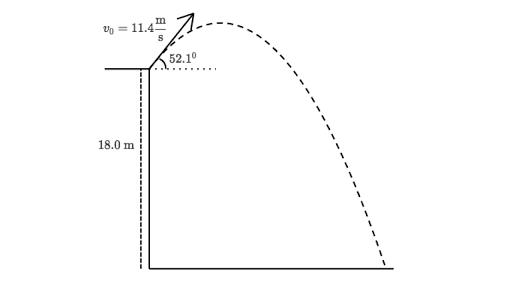Projectile Motion Calculator

This calculator helps to determine parameters of projection, or ballistic motion. The parameters of projection, as shown on picture, are:distance,maximum height,flight duration,initial angle,initial velocity.The main equations are:These formulae are produced from equations of accelerated motion with the assumption that there is no acceleration along x-axis and only gravity acceleration 'g' along y-axis.Calculator can find unknown parameters for any pair of known parameters.That is, it calculates the flight duration, maximum height and travel distance of the projection from the initial velocity and angle. Or it calculates the initial velocity, travel distance and flight duration of the projection from the initial angle and maximum height. The only illegal combination of parameters is maximum height and flight duration. Given only these, it is impossible to find others.
If you fire a projectile at an angle, you can use physics to calculate how far it will travel. When you calculate projectile motion, you need to separate out the horizontal and vertical components of the motion. This is because the force of gravity only acts on the projectile in the vertical direction, and the.
Do you want to analyze parabolic projectile motion? What about knowing more about what it means? Do you want to determine projectile motion equation values?Below, you can learn all this and more. Use a projectile motion calculator to learn about velocity, flight, and projectile ranges. What is the Definition of Projectile Motion? For an example of projectile motion, let us look at a golfer. Imagine him hitting the ball, blasting it forward and up.
The further it moves toward the green, the slower its ascent becomes. It will then start its descent, showing promise for that elusive hole-in-one!Pay attention to the movements that ball made. It would look like a curve (trajectory) in a parabolic shape. Anything forming that movement, like an archer shooting an arrow, is projectile motion.In that motion, there is one force: gravity. If you involved a second force, then it would not be a projectile.

Analyzing Projectile Motion Projectile motion might look complicated, but it involves logic. Twisty the clown. Once you know the initial velocity ( v), launch angle ( α), and initial height ( h), use the calculator.
The calculator uses the following steps to work out the remaining parameters for you.1.Calculate your velocity components. Horizontal velocity (Vx) = V x cos (α)- Vertical velocity (Vy) = V x sin (α)- Three vectors (V, Vx, and Vy) = a right triangleIf the vertical velocity is zero, then you have horizontal projectile motion. If α = 90°, then it’s a freefall.2.Establish the equations of motion. Distance - Horizontal distance traveled is x = Vx x t (time)- Vertical distance from the ground is y = h + Vy x t – g (gravity) x t² / 2 Velocity - Horizontal velocity = Vx- Vertical velocity = Vy – g x t Acceleration - Horizontal acceleration = 0- Vertical acceleration = -g (gravity acts on a projectile) 3.Calculate the flight timeThe flight time ends when the projectile hits the ground. You can determine this as being when the vertical distance to the ground is 0. When the height is 0, the formula is:Vy x t – g x t² / 2 = 0Using that formula, you can establish the time of flight is:t = 2 x Vy / g = 2 x V x sin (α) / gIf you are adding elevation to the object, you solve a quadratic equation first.h + Vy x t – g x t² / 2 = 0Solve that equation to get:t = V x sin (α) + √(V x sin (α) ) ² + 2 x g x h / g 4.Calculate the projectile’s rangeThe total horizontal distance during travel dictates the projectile’s range. If you launch a golf ball from the ground (height = 0), the formula will be:R = Vx x t = Vx x 2 x Vy / gSimplify it to:R = V² x sin (2α) / gWhat if the initial elevation is not 0?
The long formula needs some minor alterations:R = Vx x t = V x cos(α) x V x sin(α) + √ (V x sin(α)) ² + 2 x g x h) / g5.Calculate the maximum heightYour golfball will reach a point when it reaches its maximum altitude. When it does, it will start falling. The vertical velocity then changes from a positive number to a negative one. It becomes 0 for a moment in time.t (Vy = 0)This equation:Vy – g x t (Vy = 0) = 0Then becomes:t (Vy = 0) = Vy / gAll you need to do then is find the vertical distance from the ground:hmax = Vy x t (vy=0) – g x (t(Vy=0))² / 2 = Vy² / (2 x g) = V² x sin(α)² / (2 x g)When you launch an object from an initial height (h), you only need to add that value to the final formula:hmax = h + V² x sin(α)² / (2 x g) Equations for Projectile Motion After reading the above steps for calculating projectile motion, you might feel frazzled!